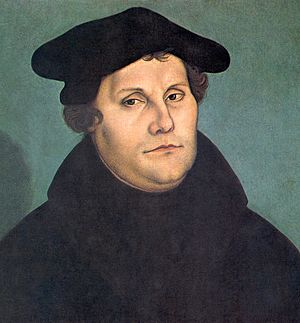Christum wir sollen loben schon, BWV 121 facts for kids
Quick facts for kids Christum wir sollen loben schon |
|
|---|---|
|
|

Martin Luther, author of the hymn
|
|
| Occasion | Second Day of Christmas |
| Performed | 26 December 1724: Leipzig |
| Movements | 6 |
| Vocal |
|
| Instrumental |
|
Christum wir sollen loben schon (which means "We should praise Christ highly") is a special piece of music called a church cantata. It was written by the famous composer Johann Sebastian Bach. This cantata, also known as BWV 121, is a Christmas cantata because Bach composed it for the second day of Christmas. He first performed it in Leipzig, Germany, on December 26, 1724. It's a type of chorale cantata, which means it's based on a well-known hymn (a religious song). The hymn for this cantata was "Christum wir sollen loben schon" by Martin Luther.
Contents
What's the Story Behind It?
Bach wrote this cantata during his second year living in Leipzig. It was for the second day of Christmas, a special church holiday. The music tells a story related to the Christmas season.
The main song for this cantata comes from a hymn by Martin Luther. Luther was a very important religious leader. His hymn, "Christum wir sollen loben schon", is a German version of an old Latin song.
Bach used the first verse of Luther's hymn for the opening part of his cantata. He used the last verse for the very end. The parts in between were new words written by someone else. These new words were inspired by the hymn's message.
Who Plays and Sings?
This cantata is performed by a four-part choir. This means it has singers for soprano, alto, tenor, and bass parts. There are also special solo singers for the alto, tenor, and bass voices.
The instruments include a cornett (an old wind instrument), three trombones, an oboe d'amore (a type of oboe), two violins, a viola, and a basso continuo. The continuo usually involves a cello and an organ or harpsichord.
How Is It Organized?
The cantata has six main parts, called movements:
- Chorus: Christum wir sollen loben schon
* This is the big opening part sung by the whole choir.
- Aria (tenor): O du von Gott erhöhte Kreatur
* An aria is a song for a single singer, here for the tenor voice.
- Recitative (alto): Der Gnade unermesslich's Wesen
* A recitative is like musical talking, here for the alto voice.
- Aria (bass): Johannis freudenvolles Springen
* Another solo song, this time for the bass voice.
- Recitative (soprano): Doch wie erblickt es dich in deiner Krippe
* A short, expressive musical talking part for the soprano voice.
- Chorale: Lob, Ehr und Dank sei dir gesagt
* The final part, sung by the choir, often like a hymn.
What Does the Music Sound Like?
The first movement, sung by the choir, sounds very old-fashioned. It uses a special melody from the hymn. The brass instruments (cornett and trombones) play along with the singers. This creates a grand and ancient sound.
The tenor aria is a beautiful solo song. It features a special part for the oboe d'amore. It has a unique, slightly "off-kilter" feel, making it interesting to listen to.
The bass aria is lively and almost like a dance. It has a repeating musical idea played by the strings. This part of the music helps to show the joy mentioned in the words.
The very last movement is a chorale. It's a powerful ending where the choir sings the hymn melody. It brings the whole piece to a strong finish.
Images for kids
See also
 In Spanish: Christum wir sollen loben schon, BWV 121 para niños
In Spanish: Christum wir sollen loben schon, BWV 121 para niños

